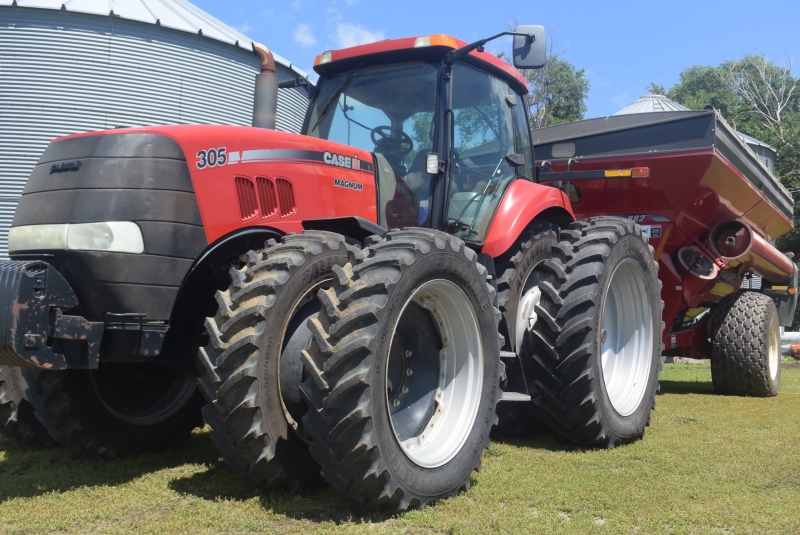Does Tread Depth Equate to Tire Longevity?
It seems so obvious: the deeper a farm tire’s tread, the longer it should last. After all, a tire with more tread should take longer to wear through its copious amounts of rubber than a tire with less tread, shouldn’t it? The answer isn’t so clear, however, as a multitude of characteristics—including tread depth—factor into the lifespan of a farm tire. Don’t let this misconception lead you astray when it comes time to buy farm tires; keep reading to learn all of the factors that go into getting the longest lasting tires for your machine.

R1, R1W, and R2 Tires
Before diving too far into the numerous ways tread depth affects tire life, it’s important to understand the three labels that manufacturers use to categorize tire depth: R-1, R-1W, and R-2.
R-1 tires have a tread depth of 1.25 to 1.75 inches and have long been considered the standard tire for general farming. R-1W tires (the W stands for wet) are best thought of as traditional R-1 tires with 20 to 25 percent more tread depth, giving them an advantage over R-1 tires in wet soils where traction is the primary concern. R-2 tires feature huge lugs with a depth of three inches or more, and unlike R-1 and R-1W tires that float equipment on top of the field, R-2 tires dig through wet surface soil mud to get to the drier ground below.
Application-Specific Tire Options
How farm tires are used and the type of surfaces in which they’re operating has an enormous impact on the lifespan (and total cost of ownership) of a tire—making them important considerations when deciding how much tread depth is needed in a tire. Typically, as tires increase tread depth they also add cost. This makes choosing a tire properly matched to its intended application critical, as the wrong tire could not only wear faster but also cost more.
For example, tractors that are used around the yard, in feedlots, or that spend a lot of time on the road will see no benefits from investing in a deep-treaded R-1W tire. In addition to the increased cost, an abundance of hard surface use will only expedite the wear of a more robustly treaded tire. Likewise, a tractor working in muddy rice or sugar cane fields or wet midwestern soils will benefit from the increased traction found in R-1W tires—the additional cost of the tires may even be offset by the increased productivity, efficiency, and fuel economy provided by the tire.
Think about it in terms of baseball cleats. On the diamond, those expensive cleats will give you great traction and last a long time. But walking around town on the sidewalk, the cleats won't offer much use for traction, they’re awkward to walk in, and they'll grind down to nubs in a hurry. You're better off in a pair of boots or sneakers.
The War Against Wear
Heat is the enemy of tires. In general, tires with substantial treads are heavier than tires with slight treads, which increases their rolling resistance and leads to heat build-up. Deeper-treaded tires are not able to dissipate heat as quickly as tires with shallower tread patterns, and, the wiggling movement of the tread bars on hard ground or pavement can create considerable heat. This is an especially important consideration for tires on machines that will see a lot of time on the road, as their lugs can heat up, causing increased flexing and leading to premature wear.
We know that every tire—even the ones best suited to mud—have to spend some of their time on the road. That's why we've worked so hard to build roadability and endurance into even our mud-hungriest R-1Ws and R-2s. For example, the Alliance AgriFlex+ 354 (an R-1W tire) is able to travel at speeds of up to 40 mph both on- and off-road thanks in part to its unique tread design. Alliance’s new Agristar 374 (an R-2 tire) provides the perfect balance of on-road performance with the ability to handle to muddiest fields.
Proper Inflation for Increasing Tire Life
Even if you pick the perfect tire for the intended application, it’s imperative to operate the tires at their proper inflation pressure to ensure a long life. Underinflation can lead to a host of tire-killing problems ranging from uneven wear to overheating—which, in the worst scenarios, can cause them to separate or explode. Overinflating tires can rob machines of performance and also create uneven wear.
 We're dedicated to making application-specific tires that solve the real-world problems facing our customers. When it comes time for new tires, don’t let tread depth be the only determining factor—work with your local dealer or rep to find the right tire for your application.
We're dedicated to making application-specific tires that solve the real-world problems facing our customers. When it comes time for new tires, don’t let tread depth be the only determining factor—work with your local dealer or rep to find the right tire for your application.

